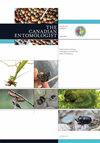Interactions between the Fungal Symbiont of Sirex noctilio (Hymenoptera: Siricidae) and Two Bark Beetle-Vectored Fungi
IF 1.1
4区 农林科学
Q3 ENTOMOLOGY
引用次数: 28
Abstract
Abstract The woodwasp Sirex noctilio F. is invading North American forests, where it will interact with a large guild of pine-inhabiting beetles and their associated fungi. The woodwasp's obligate fungal symbiont, Amylostereum areolatum (Fries) Boidin (Stereaceae), plays an essential role in the wasp's larval development but is expected to be a poor competitor in the presence of fungi vectored by co-occurring insects. We examined the outcomes of competitive interactions between A. areolatum and two fungal species vectored by bark beetles, Leptographium wingfieldii Morelet (Ophiostomataceae) and Ophiostoma minus (Hedgcock) H. and P. Sydow (Ophiostomataceae), and the effect of temperature and substrate on these interactions. Beetle-associated fungi were usually able to capture more uncolonized resource than A. areolatum regardless of substrate or temperature. Amylostereum areolatum was able to colonize relatively more space in some cases but could not gain substrate already colonized by the ophiostomatoid competitor. These findings suggest that competitive interactions between beetle-vectored fungal species and A. areolatum could influence the reproductive fitness and distribution of S. noctilio within individual trees and also across a wide geographic area.夜蛾丝虫病媒真菌(膜翅目:丝虫病媒真菌科)与两种树皮甲虫病媒真菌的相互作用
森林黄蜂Sirex noctilio F.正在入侵北美森林,在那里它将与栖息在松树上的甲虫及其相关真菌相互作用。木胡蜂的专一性真菌共生体,Amylostereum areolatum (Fries) Boidin(木胡蜂科),在木胡蜂的幼虫发育中起着至关重要的作用,但在共生昆虫的真菌媒介存在下,预计将是一个糟糕的竞争对手。研究了以树皮甲虫为媒介的两种真菌Leptographium wingfieldii Morelet (Ophiostomataceae)、Ophiostoma minus (Hedgcock) H.和P. Sydow (Ophiostomataceae)与A. areolatum的竞争互作结果,以及温度和基质对这些相互作用的影响。无论底物或温度如何,与甲虫相关的真菌通常能够捕获更多的非定殖资源。在某些情况下,平纹直链淀粉能够在相对较大的空间内定殖,但不能获得已被蛇口类竞争者定殖的底物。这些研究结果表明,甲虫媒介真菌与沙纹夜蛾之间的竞争相互作用可能会影响夜蛾在单株内以及在广泛的地理区域内的繁殖适应性和分布。
本文章由计算机程序翻译,如有差异,请以英文原文为准。
求助全文
约1分钟内获得全文
求助全文
来源期刊

Canadian Entomologist
生物-昆虫学
CiteScore
2.20
自引率
11.10%
发文量
24
审稿时长
6-12 weeks
期刊介绍:
French translation follows/le français suit Published since 1868, this peer-reviewed bimonthly publication is the official journal of the Entomological Society of Canada. Available via the internet and with hardcopy distribution to 55 countries, its research papers and notes are relevant to entomologists and other biologists around the world. In addition to being a venue for topical reviews and forum discussion, The Canadian Entomologist publishes current research in all facets of entomology, including systematics and morphology, molecular and developmental biology, ecology and behaviour, biodiversity and evolution, insect management, entomological techniques, and other relevant subject areas. Contributions are published in English or French. Authors will not pay page charges, and will experience fast, high quality reviews of their papers.Publiée depuis 1868, cette publication bimestrielle avec comité de lecture est la revue officielle de la Société d’entomologie du Canada. Disponible sur Internet et distribuée en format papier dans 55 pays, ses articles de recherche et ses notes sont pertinents pour les entomologistes et autres biologistes de par le monde. En plus d’être une plate-forme pour des revues thématiques et un forum de discussion, The Canadian Entomologist publie la recherche actuelle sur toutes les facettes de l’entomologie, incluant la systématique et la morphologie, la biologie moléculaire et développementale, l’écologie et le comportement, la biodiversité et l’évolution, la gestion des insectes, les techniques entomologiques et d’autres domaines pertinents. Les contributions sont publiées en français ou en anglais. Les auteurs ne paient aucun frais de publication, et recevront une révision rapide et de grande qualité de leurs articles.
 求助内容:
求助内容: 应助结果提醒方式:
应助结果提醒方式:


